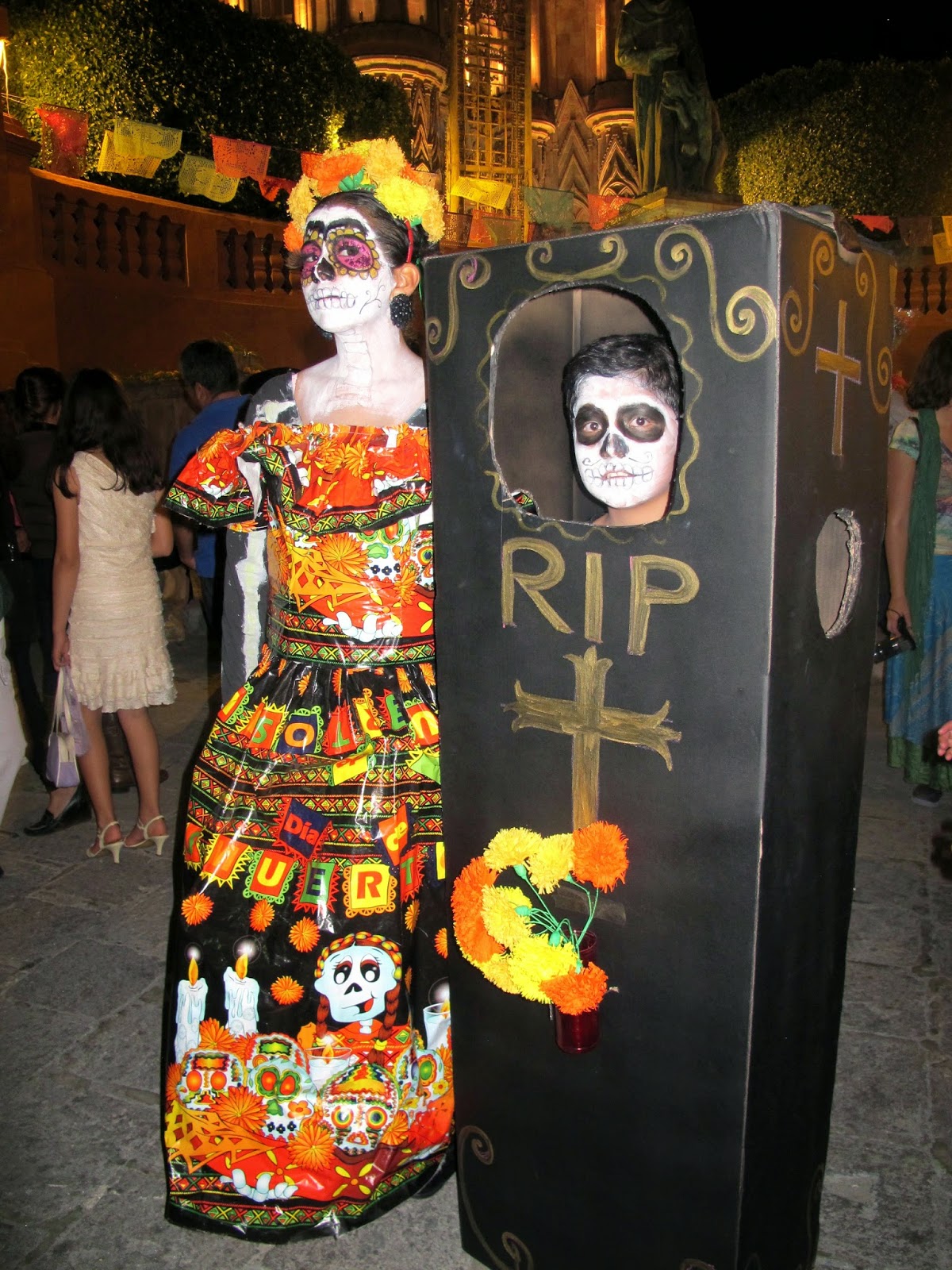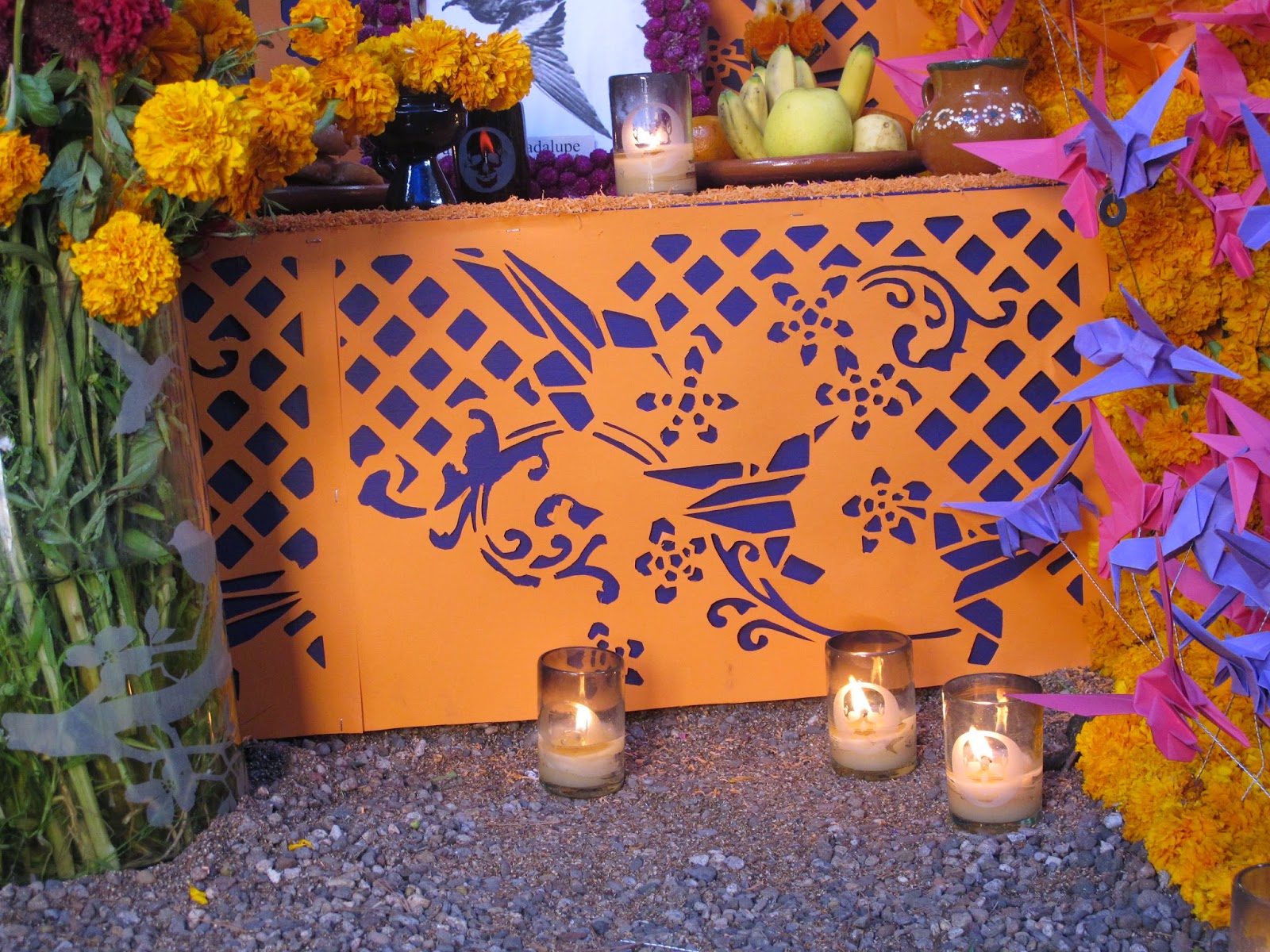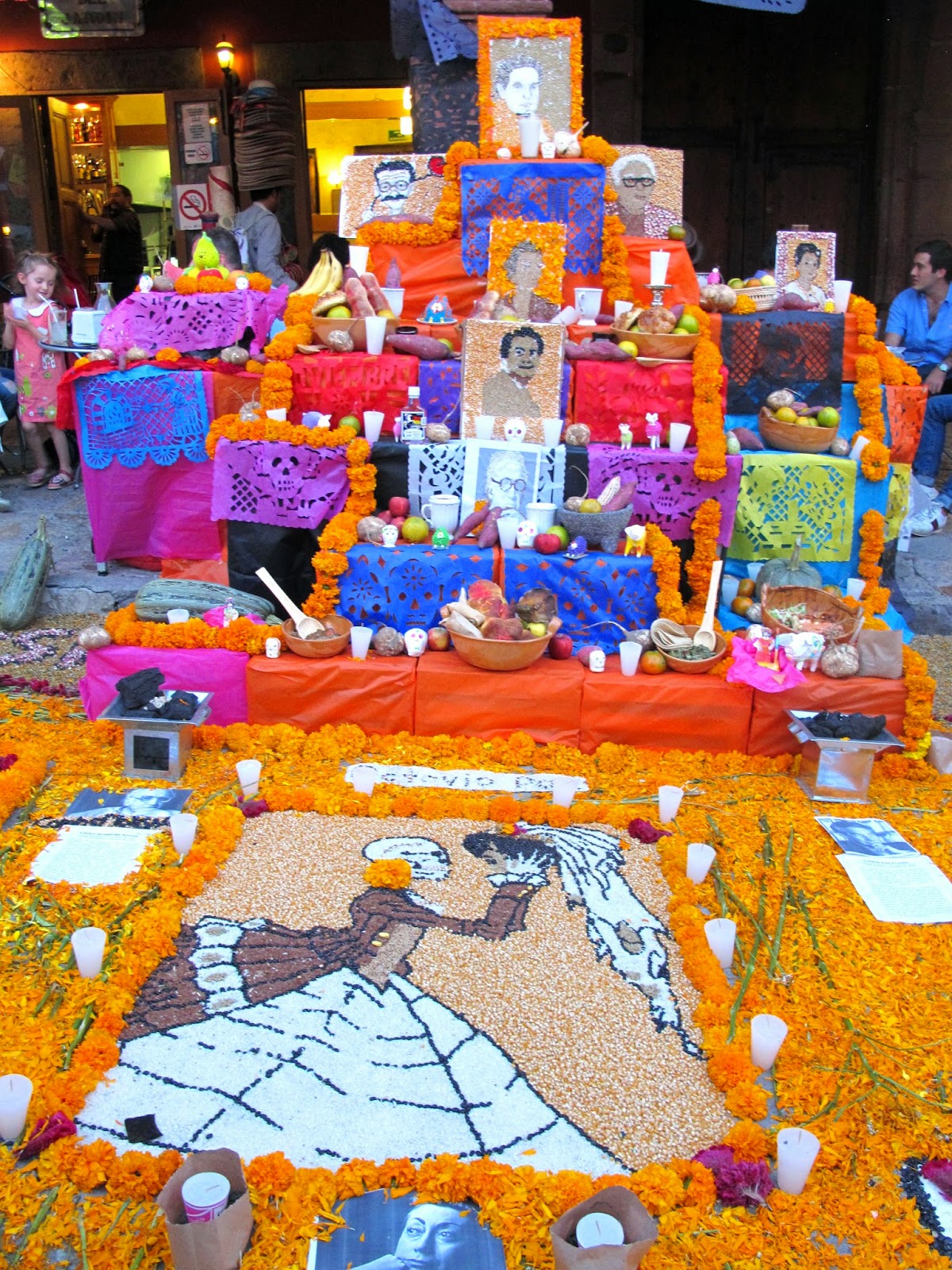skip to main |
skip to sidebar
I just adore the way the children get involved with Los Dias de Muertos. This little guy was coming home from school and I was just coming out of the Diego Rivera Museum in Guanajuato. I said, "Hola Guapo" (Hi handsome). With a big grin on his face, he stopped so I could take his photo.
Up in the jardin (the main plaza) in San Miguel with hordes of people dressed up in a variety of costumes. I have never seen such a beautiful little devil before than this little gal.
The Bell of the Ball.
Great job on her makeup with the garland of yellow flowers painted on her forehead.
A lovely "Frida Kahlo" with the walking "RIP" coffin. Wonderful.
Such creativity in this costume! Strips of magazine pages woven to make bodice of the dress, black plastic bags for her sleeves, layer after layer of crumbled white paper for the skirt and her large hat comprised of cookie and candy bags are just magnificent. This certainly gives true meaning to recycling!
Talk about forlorn. I think someone was ready to go home and hit the hay.
Having dinner at La Brasserie at Calle Jesus 11 in San Miguel de Allende and there was a steady stream of costumed children walking by. First this little gal appeared in the window.
Next her brother. I just love how this brother and sister seem to not have a care in the world except enjoying the evening out and definitely their suckers. Life is grand!
The altar (ofrenda) is a wonderful time to cherish the loved ones, ancestors and friends who have passed on . It is a colorful event in which the ofrenda is a display in ones home, a local shop or ones property which provides a feast for the visiting spirit.
Favorite items of the person being honored are included in the altar.
My home altar is in honor of my beloved brother, Carter Kane Mullen. Every year I honor his memory in this niche in my home.
Many of Carter's favorite things: a bottle of Turnbull Cabernet Sauvignon , a shot of tequila, a basketball, a book on hiking the Grand Canyon and Lake Powell, masks representing his Mexican mask collection that I donated in his behalf to the Museo de las Americas here in Denver, a CD by The Who (I had asked him once if he could be a musician, what instrument, etc. ... he said he would be Pete Townshend of The Who and play guitar), a pear (his favorite fruit), some dogs, pheasant feathers for his love of bird hunting, a heart milagro representing the big generous heart he had, Sudoku (a morning ritual while having breakfast) and his infamous red pen that he used to edit copy at his advertising and public relations agency.
Leaving Atotonilco, I passed this wonderful altar with Marigolds, skulls and paper flowers. The Marigold, Cempasuchil, is the most traditional flower used. In Aztec times, is was the flower of 400 lives. Its fragrance leads the spirits home.
Talk about creativity! Afredo and Jim, owners of Camino Silvestre in San Miguel, had the most incredible ofrenda. Hundreds of hand-made origami hummingbirds in flight.
And the hummingbird papel picado they made was beautiful.
Candles represent fire and a light to guide the spirit back to the living. Copal, incense, is burned and thought to elaborate prayers to God.
This colorful altar was at the Diego Rivera Museum centered around the fountain that was on the main floor of the house he grew up in as a child. Colorful tissue paper, papel picado, is cut into intricate designs. A throw back to the Aztecs who used paper banners in their rituals. Each color has a different meaning: pink for celebration, white for purity and hope, purple from Catholicism representing pain, suffering and mourning, yellow and orange for the Cempasuchil, the sun and light and red for the blood of Jesus for Christians and for the indigenous, the blood of the people and animals.
The main plaza, el jardin, in San Miguel de Allende came to life over night with altars honoring past musicians.
I love the creativity of using large ceramic comals (Mexican griddles) as the canvas for the portraits.
The use of different grains, corn and seeds along with the marigolds and cocks comb is brilliant.
What a special way to celebrates the lives of our loved ones that have passed on. Those we will never forget and who are with us in spirit everyday.
It is that time of year when many parts of Mexico are gearing up for the festivities of Los Dias de Muertos, The Days of the Dead. This traditional holiday from October 31 - November 2 honors departed ancestors, friends and family.
The markets explode with huge displays of deep yellow-orange marigolds (flores de Cempasuchil), vibrant magenta Cockscomb (Cresta de Gallo) and Baby's Breath (Aliento de Nino), all sold for decorating of altars and graves. The Cempasuchil dates back to Aztec times, the flower of 400 lives.
This woman was in the courtyard of the Valencia Church, just north of Guanajuato, selling flowers for home altars.
I was blown away by the length of these sunflowers and Calla Lilies.
Stalls popped up over night in front of the Oratoria church in San Miguel de Allende.
You will find countless candles of all sizes in white and different shades of orange along with papel picados (for more on papel picados, see my post on 5/21/2014).
Shelf after shelf of sugar art in all shapes. Sugar art was originally brought to the new World in the 1600's by Italian missionaries. This tradition of sugar lambs and angels were made to decorate the side altars in the churches at Easter time. At the time, Mexico was rich in sugar production but too poor to buy the elaborate decorations from Europe. The friars taught the locals to the make the sugar art for their own religious occasions.
Sugar skulls represents the soul of a departed love one and often have the name of that person on it. They are created by using a clay mold and then decorated with colorful icings, shiny tin foil and glitter.
I was particularly impressed with the little molcajetes with its tejolote (the indispensable piece of kitchen gear, the volcanic rock mortar and pestle) filled with guacamole. Food offerings (afrendas) are a very important part of the ritual.
It's a festive time of year and a great time to wander around the different stalls to see which each stall has to offer.
Last year I had a great time decorating for my Dias de Muertos dinner party. The table cloth is some fabric that I had bought in Oaxaca at this huge fabric store. Of course when I got home, I hemmed it by hand.
Every time I went to the market, I had to buy another piece of sugar art.
Just wait until you see how I am decorating my table this year!
I made a delicious pizza with Italian sausage, thinly sliced garlic, Piquillo peppers and capers. The saltiness of the capers add a great dimension to all of the other flavors.
To make life easier, I buy the pizza dough at Whole Foods. I like the taste of the crust and it is well priced. All I have to do is take it out of the refrigerator and let it come to room temperature for about 30 minutes. (Twice I have tried the dough from Trader Joe's and I did not care for it at all, it lacks flavor)
The night before, fry up some mild Italian sausage, drain it and put it back in the refrigerator until needed.
It just dawned on me, the color of the garlic, capers and peppers are like the Italian flag. How appropriate for a pizza.
I like to use Tarantino mild Italian sausage that I buy at Costco for my pizzas. It comes in four packets with six sausages in each packet. I store them in the freezer, perfect to have on hand. It crumbles nicely once cooked and has a slight hint of fennel to it.
Pizza Ingredients:
1 lb. pizza dough
1 12 oz. jar of Piquillo Peppers - use 6 ounces - drained and sliced
(save the remaining peppers for another use...
in an omelet, on a bruschetta with some goat cheese...)
Olive Oil
10 garlic cloves, thinly sliced (about 1/3 cup)
1 heaping tablespoon capers, rinsed well
3/4 lb. mild Italian sausage (about 3 sausages), fried and drained
1 1/2 cups grated cheese: a mix of Mozzarella, Provolone, Parmesan
In a large skillet, heat 1 tablespoon of olive oil. Add the garlic and saute until almost golden. Add peppers and caper. Saute for another minute. Take of the heat and set aside.
Roll out the dough to your desired size. The pizza stone that I use is 12" x 15". Brush the pizza stone with a little olive oil. Place your dough on the stone. Brush the pizza dough with a little olive oil. Assemble the pizza with the sausage, then the garlic, caper and pepper mixture, then the cheese. Of course you may add or subtract how much of the topping goes on your pizza.
Bake in a 450 oven for about 14 minutes or until the crust is a light golden brown.
Bon Appetit!
The other day I ran across a box of Pichuberries at the grocery store and even though I had already planned my menu for my dinner party the next night, I could not resist buying a box. My first encounter with a Pichuberry was at one of my favorite restaurants in Barcelona, Ca I'sidre.
The Pichuberry, also known as Physalis Peruviana, is a fruit that grows on bushes. In Peru it is also known as an Aguaymanto or Inca Berry. In the states, it is often referred to as a Gooseberry. Like a tomatillo, it has a papery calyx that protects the fruit. With this calyx, the shelf life is about 30 to 45 days at room temperature.
When the skin is peeled back, you will find a deep yellow-orange berry, about 3/4" in diameter. It contains seeds like a tomato. When ripe, it is sweet with just a bit of tartness, similar in taste to a kiwi.
It is one of the most abundant sources of vitamin C, 20 times that of an orange. It is a powerful antioxidant and helps boost the immune system.
Earlier in the day, I caramelized a cup of sugar. (See my blog dated April 9, 2014 on The Best Flan. I explain how to caramelize sugar). I peeled the skin back in a few sections and inverted the leaves in the opposite direction. Using the skin as a little handle, I dipped each berry into the hot caramelized sugar and then placed each on metal tray to harden.
Adding an exotic twist to my presentation, it was the perfect accompaniment to the chocolate mousse!
This week I biked up the North Platte River trail with a few friends. We got off around 52 and Race Court and biked over to Brighton Boulvevard to enter the Riverside Cemetery. We have always been intrigued by the sight of it when we had seen it across the Platte River on previous bike rides. Talk about bad timing though, just as we were about to enter the cemetery, a never-ending train crossed our path.
Riverside is Denver's oldest operating cemetery that was founded in 1876. The 77 acres is rich in history with the final resting-places of prominent men from historic Colorado, distinguished Colorado women and over 1,200 Civil War veterans.
The grounds are divided into 38 sections (stations) that are designated by green corner markers.
At station 15, you will find the large bronze statue of Col. James Archer. In 1871, Archer built Denver's first gas works and brought gas lights to the city. He also was responsible for the first piped water system in Denver.
In section 27, often referred to as the GAR Block, for is the location of many of the Union soldiers found at Riverside. GAR stands for the Grand Army of the Republic. You will find the marker of John Crump, the oldest Civil War veteran at Riverside. Born into slavery in Washington D.C. in 1799 and he died at the age of 104 in 1903.
The only woman included in the GAR, is Frances Klock for she was a charter member of the Women's Relief Corps, Auxiliary to the GAR. In 1906 this women's group took over the Andersonville prison site and created a garden in memorial to the 13,000 men that had died there. She was instrumental in the women's right to vote in 1893 (Colorado being the second state to achieve this honor). After she was elected to the state legislature, one of three women at the time.
In section 1, you will find the marker of David Frakes Day, a three Medal of Honor recipient. Like many of his time, he lied about his age in order to enlist in the 57th Ohio. He was 15 years old. He was on the front line with General Grant in Vicksburg. He was captured three times and successfully escaped each time. After the war, he went into the newspaper business.
In section 28, part of the area is dedicated to 69 tombstones of women who lived at the Old Ladies Home.
Residents of the home had to be at lest 65 years old, of good standing and a resident of Denver for at least five years. Originally opened in 1874 at 800 Logan Street, its current location at 4115 W. 38th Avenue is still in operation with the name of The Argyle which now accepts male residents.
You will find the markers of children who died in the the Denver Orphans' Home.
One of the 46 Colorado Pioneers is Edmund A. Willoughby; builder and inventor of the famous Willoughby brick and sheriff of Arapahoe county.
Also in section 28 is William Green. He died in 1915 at the age of 89 and at the time, he was considered the oldest surviving Colorado pioneer. He was elected to the first Colorado State Legislature, was Captain in the 2nd Cavalry in the Civil War and after the war, served as a scout along side Buffalo Bill Cody. It was only fitting (and symbolic) that this pioneer was the person chosen to flip the switch that lit the Gas and Electric building for the first time. This Denver icon has an exterior that is illuminated by thousands of light bulbs set into the stone work.
Elizabeth Brown Lennon and her husband John were abolitionists who sheltered runaway slaves in their home in Missouri before the Civil War. Her brother, Jenry Cordes Brown, donated the land where the state capital was built and built the Brown Palace Hotel which used to be the site where he corralled some of his cattle.
You will find an interesting limestone replica of Lester Drake's mining cabin in section 4. Note the details of the ivy growing up the facade and the latch rope on the door along with mining tools. Drake was gold mining pioneer in Balck Hawk.
Section 16 has three markers that are very touching, for the three Clifton Bell children died at a very early age. Stella's marker is that of a young girl holding a doll.
In section 16, you will find three private family Mausoleums.
All three structures are interesting from the west side. This one is Gen. Ovando J. Holister's tomb where he and his wife rest.
Such a delicate statue on top of the tombstone of Janet McNeil.
(May 25, 1855 - November 2, 1888).
Beautiful fall colors adorned the mausoleums.
Gorgeous weathered wrought iron cross.
This statue in section 14 is one of a kind in all of the cemeteries in the United States. It is the marker of Addison Baker, farmer and rancher who settled in west Denver. This life-size replica is of his Arabian stallion, Ali, is unique for this horse has no rider, saddle, tack or any other adornment.
In section 15E, there is the tombstone of Rufus Clark. I was impressed in his background and wealth that he achieved. He came to Colorado in 1859 and grew potatoes. He homesteaded 170 acres which now known as Overland Park and Golf Course, an area that we bike by often when on the South Platte River Trail. In 1867 he delivered $1,500 worth of potatoes to Denver one day and in that year he earned $30,000! He also donated 80 acres which is the home for the Denver Seminary at University and Evans.
I have barely scratched the surface of all the life stories behind each of these tombstones. What a ride through time when we visited the Riverside Cemetery and rode our bikes and walked as we learned about the many interesting people buried here.
There are walking tours at the cemetery and I know there is one coming up especially for Halloween. I bought three booklets on a previous occassion and what an interesting read. They are "Walk Through Historical Riverside Cemetery", "The Civil War at Riverside" and "Riverside Cemetery Distinguished Colorado Women".
Riverside Cemetery
5201 N. Brighton Blvd.
Denver, CO 80216





















































